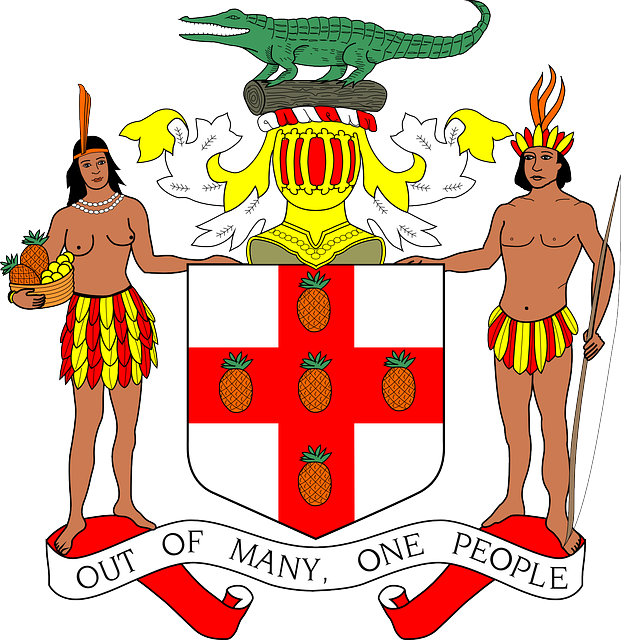By Tim Lambert
Early Jamaica
From about 800 AD a people called the Arawaks lived in Jamaica. They were stone age farmers although they also hunted and fished. The Arawaks grew beans, cassava, and maize. They also grew cotton.
However, in 1494, Christopher Columbus landed in Jamaica. The Spanish and Arawaks briefly fought each other but the Spanish easily won because of their superior weapons. Nevertheless, Columbus soon sailed away and the Spanish showed little interest in Jamaica. In 1503 Columbus sailed to Jamaica again and he and his crew were marooned there for a year.
Jamaica was then left until 1510 when the first Spanish settlers arrived. Juan de Esquivel led them and at first, they settled at a place called Sevilla Nueva (New Seville) but in 1534 they moved to Villa de la Vega (Spanish Town). The Spaniards grew sugar and bananas in Jamaica but it remained mainly a re-supplying stop between Central America and Spain.
Meanwhile, the native peoples were decimated by European diseases. They were also enslaved. Eventually, the native population was almost wiped out. From 1517 the Spaniards imported African slaves to work in Jamaica.
Then in 1654 Oliver Cromwell, ruler of England decided to try and capture Spanish colonies in the Caribbean. He sent an expedition under Robert Venables and William Penn. They attacked the island of Hispaniola in April 1655 but they were driven off so they sailed to the weakly defended island of Jamaica. They landed in May 1655 and the Spanish retreated inland. For 5 years they fought a guerrilla war against the English but they were crushed at the battle of Rio Bueno in 1660. Meanwhile, English and Scottish settlers came to Jamaica and began to form plantations.
In 1664 the English joined forces with Buccaneers (pirates) against Spain and Port Royal became a Buccaneer base. However, in 1670 Spain formally surrendered Jamaica to England. The Buccaneers ceased to be useful and became a nuisance. However, in 1692 an earthquake struck Port Royal and toppled it into the sea.
During the 18th century, sugar plantations in Jamaica flourished. However, they depended on slavery, which caused great human suffering. Not surprisingly the slaves often rebelled but all their rebellions were eventually crushed.
As well as slave rebellions the British faced a threat from people called the Maroons. When the Spanish were driven out of Jamaica they set their slaves free. These freed slaves were known as Maroons and their numbers were swollen by slaves escaping from plantations. In 1739 the British launched a campaign to destroy the Maroons but they failed. So in 1739 and 1740, they signed peace treaties with them. The Maroons were granted land in Jamaica and in return, they agreed to return runaway slaves and to help to put down rebellions. Nevertheless, the Jamaican slaves continued to rebel.
The most serious rebellion was the Christmas Rebellion of 1831, which was led by Sam Sharpe. As many as 20,000 slaves took part. However, the rebellion was crushed and hundreds of slaves were killed. Yet slavery was finally abolished in Jamaica in 1834.
However, the freed slaves were not necessarily economically better off as they had to work for very low wages. Furthermore, during the 19th century, the Jamaican sugar plantations declined. That was partly due to competition from sugar cane growers elsewhere and it was partly due to Europe growing sugar beet.
In 1865 popular discontent boiled over into rebellion at Morant Bay. The rebellion was led by Paul Boge but it was soon crushed. Then in 1866, Jamaica was made a crown colony governed directly by Britain, which allowed certain reforms to be made. In 1872 the capital of Jamaica was moved to Kingston.
Modern Jamaica
In the 1890s tourists from the USA went to Jamaica on banana boats. n Jamaica in the 20th Century n In the early 20th century Jamaica was quite prosperous – although the prosperity was not shared by all. Many people were still very poor.
Then in the 1930s, Jamaica was badly hit by the depression. There were strikes and riots and in 1938 there was a battle between workers and police at the West Indies Sugar Company in Frome. Several people were killed. As a result, Alexander Bustamante formed a trade union, the Bustamante Industrial Trade Union. Meanwhile, Norman Manley formed the People’s National Party. Both campaigned for political and economic reforms.
In 1944 all Jamaicans were given the vote and a new constitution was introduced allowing an elected government to work with the British governor. Jamaica finally became independent on 6 August 1962.
The 1960s were years of prosperity for Jamaica and the bauxite industry thrived. However, in 1972 Michael Manley won the election and he introduced Socialism. The result was a flight of capital from Jamaica. Many wealthy Jamaicans also left the country. Manley also forged links with Cuba, which antagonized the USA.
The 1976 election was marred by violence but Manley won again. The 1980 election also witnessed violence but this time Manley lost.
Under Edward Seaga prosperity returned to Jamaica to a certain extent. Ties with Cuba were severed. However, in 1989 Manley won the election but this time he reinvented himself with more moderate policies. In 1992 Percival James Patterson became the first black Prime Minister of Jamaica. Patterson won the 1993, 1997, and 2002 elections.
Jamaica in the 21st Century
Today Jamaica is still a poor country but it has enormous tourism potential. Jamaica suffered in the recession of 2009 but soon recovered. Today there is reason to be optimistic about the future of Jamaica. In 2024 the population of Jamaica was 2.8 million.

Last revised 2025